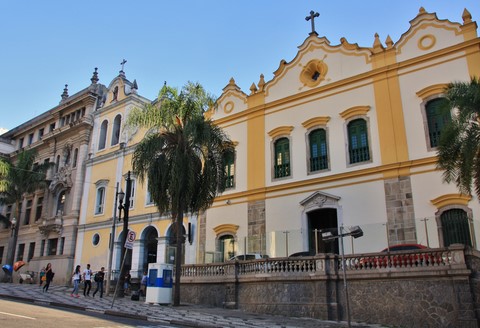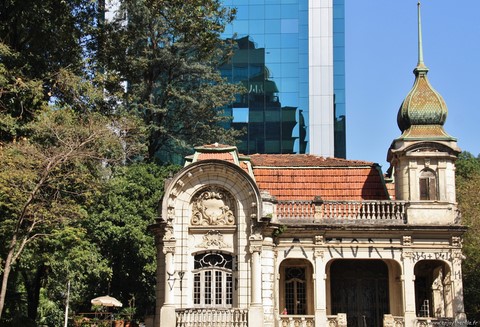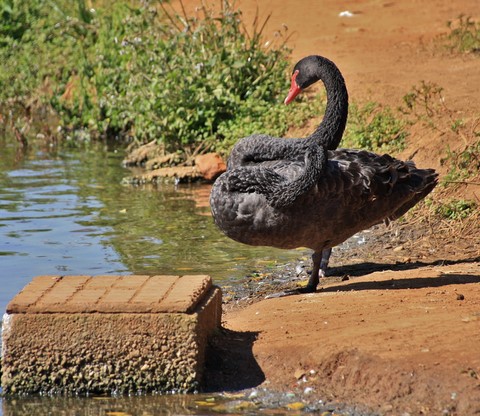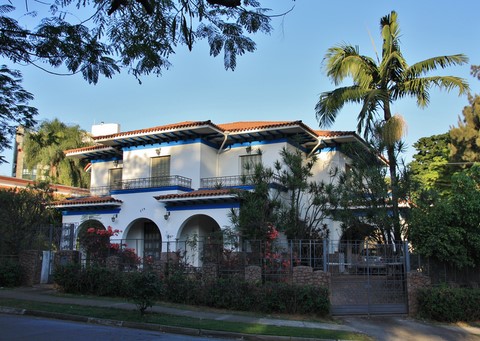São Paulo
You can click on pictures to enlarge them
Let’s not close our eyes, «Sampa» is not highly rated at first sight; nor by tourists, nor by many Brazilians. Hub of the country’s economy, it is not spared for all that by poverty and outstanding social inequalities between the rich and the poor, gap that causes unavoidably crime.
We stayed far away from the center in small and very secured residence halls in the district of the huge university - which could be itself a city – that I had the opportunity to visit, and that has its own bus network, even though city bus have access to it. Favelas are close as well.
Sprawling megalopolis poisoned by air pollution and noise pollution, traffic jams and urban violence in some districts, São Paulo is yet worth being considered from a less overall point of you, but rather with nuances. Indeed, its cultural richness, its diversity and its eclecticism in many areas are worth being known. Brazilians from other states and immigrants from Europe, Asia and the Middle East mix with locals. Hyperactive city well known for its hectic night life and its innovative spirit, notably in the social and artistic areas, it has many districts with a strong identity. Its parks and green areas are very attractive and pleasant, and allow you to escape completely from the hustle and bustle of the city yet very close.
Finally, be aware that people there are as much affable and nice as in the rest of the country.
Centro Histórico and its surroundings
Contrary to what its name could suggest, that district only has a few historic buildings. Besides, we could say so about the whole city. Honestly, we did not enjoy it that much and we did not feel completely at ease. Noisy, polluted and not much aesthetic except a few buildings, it is moreover disreputable. We stayed on our guards whenever we took our cameras for the rare times we had something to photograph.
Praça da Sé, emblematic square of the city, is also its geographic center, since there is the Marco Zero (kilometer zero) of the State of São Paulo. There, the impressive Catedral Metropolitana, Neo-Gothic style, proudly rises.
Not far from there, the Patio do Colégio, founded by the Jesuit José de Anchieta, is the cradle of the city. Originally, it was a modest straw hut, which was rebuilt in the 17th century in a Colonial style. It has a museum, a library and a restaurant. As for the Largo de São Francisco (photo), it houses the Neo-Classical style State Faculty of Law, built on the adjoining former convent. It is next to a church that has a Baroque decoration, which makes up a fine architectural grouping that displays its pastel colors, vestige of the Colonial era.
The Vale do Anhangabaú is a green area with lawns, flowers clumps and skyscrapers. To the South of it, the Viaduto do Chá, which used to stretch across tea plantations, leads to the Teatro Municipal. That last mentioned was built in the early 20th century in a similar style as the Opera Garnier in Paris. Generally, the influence of French architects and gardeners in the 10th century in the city center has never failed. We were lucky to be at an opera inside that sumptuous Neo-Renaissance and Art Nouveau style building. We could admire the splendid interior decoration made of marble and gilding, the red velvet seats and the beautiful carpet. The Mosteiro de São Bento, founded Benedictines, displays its Neo-Gothic style façades adorned with frescoes. Its stained-glass windows, its paintings and its sculptures are remarkable. Finally, Praça da Republica, where popular pedestrian streets that abound with shops start, is made of a beautiful park.
The part located North of the center is the one which has more landmarks. The Estação da Luz is one of the most iconic building in the city. Its majestic silhouette inspired from the Londoner architecture stands out on the square that has the same name. The station testifies of the importance of the coffee trading in town, that allowed it to grow rich in the past. It houses the Museu de Língua Portuguesa in one of its wings. It displays proudly its tower with a clock, like the Sala São Paulo, nearby. Besides, that is where the Symphony Orchestra moved to a home in 1999. That old station is in Neo-Renaissance style, like the Estação Pinacoteca, attached to the State Art Gallery. Both offer exhibitions of various works of art (paintings, pictures, engravings, sculptures). A little further, the Mosteiro da Luz e Museu de Arte Sacra, Baroque monastery of the 18th century, houses masterpieces of Sacred Art from the whole country. Unfortunately, it is unadvised to venture in that district at night, especially at the edge of the Estação da Luz.
West of the center, Higienópolis district is one of the most well-off in Sampa. Buildings with a wealthy charm are next to nice pleasant green areas, notably Parque Buenos Aires, made shadowy thanks to the presence of many trees. It has good restaurants and interesting museums, among others the MAB (Museu de Arte Brasiliera) and a shopping mall.
Avenida Paulista and its surroundings
Avenida Paulista (photo) is the most iconic avenue in São Paulo. First to be asphalted, it carries the symbol of the modern and forward looking aspect of the city. Displaying its numerous skyscrapers along almost 3 kilometers, it does not hide its opulence. However, some luxurious houses which owners got rich thanks to the coffee trading remain. They impose their old-fashioned charm and their great historical value in spite of the invasive display of modernism. Banks sprung up like mushrooms, as well as multinational businesses headquarters, cultural centers... Nevertheless, the MASP (Museu de Arte de São Paulo) is one of its main attractions, since it houses one of the greatest European art collection in South America. However, Brazilian artists are not forgotten. In front of it, on the other side of the avenue stands Parque Tenente Siqueira Campos (Trianon) which contains the remains of the ancient Atlantic Forest (Mata Atlântica) that used to spread over the Brazilian coast. But it was sacrificed in favor of the cultivation of sugar cane, notably in the Nordeste. It is pleasantly shadowy and allows you to disconnect from the hustle and bustle of the avenue yet very close.
Bela Vista, nicknamed «Bixiga» is the district with an Italian tradition. Stairs link its high part to its low part. Pleasant, colored and bohemian, there are naturally many Italian restaurants, as well as cafes, shops and theaters scattered among low houses. The Church Our Lady of Achiropita, with a pastel yellow Neo-Classical façade, is easily spotted thanks to its dome. The whole district celebrates the Calabria Virgin on August 15th.
According to the Liberdade district, it welcomes the Japanese community, very widespread in São Paulo (the most extensive outside Japan). Other Asians joined them, notably Chinese and Korean. Though the area is not really aesthetic, its identity is deeply rooted. The traditional sushi bars are numerous, and to a lesser extent, bazaars and massage parlors. The main attraction is the Museu de Imigração Japonesa.
Not far is Parque da Aclimação, haven of greenery which allows you to disconnect from the hustle and bustle of the vibrant São Paulo. Zoological garden inspired by the one in Paris, it has a lake inhabited by herons, swans and ducks, mainly surrounded by eucalyptus and banyan trees.
Finally, the Orthodox Metropolitan Cathedral, in Neo-Byzantine style, rises near the southern end of Avenida Paulista.
Parque do Ibirapuera and its surroundings
Parque do Ibirapuera (photo) is one of Paulistas' favorite green lung. It invites you to stroll and carefree attitude. The famous landscape gardener Roberto Burle Marx and the no less famous architect Oscar Niemeyer combined their talents to make it see the light of day. Its main attractions are the MAM (Museu de Arte Moderna) and the Museu Afro Brasil, that deals with the subject of the African heritage in Brazilian history, as the name suggests. It also includes the Japanese Pavilion, the Planetário (the first planetarium in Latin America), the Museum of Astronomy, the International Biennal of Arts in São Paulo (Fundação Bienal), and the amazing Oca Pavilion, half-sphere shaped, which proposes theme exhibition galleries. Finally, the Grande Marquise has a real architectural interest, as well as the Auditório, concert hall surmounted by a strange red canopy with the shape of a wave – or a tongue, it all depends – which leaves no one unmoved. Its lakes and its woody areas tempt to a relaxed rhythm of life and have an effect of calming and total detachment from the hustle and bustle of the city. Finally, be aware that the park has restaurants.
At the edge, the Monumento Às Bandeiras displays its silhouette. That impressive 50 meters long sculpture dedicated to the Bandeirantes, Metis explorers of the 17th century, is a line of persons carved on granite, which seems to throw themselves forwards.
Jardins district owes its name to the English garden-cities of the 19th century. It is famous for its luxurious buildings and its woody gardens. The atmosphere there is pleasant, contrary to our idea of the turbulent Sampa. Most of restaurants have a particular charm. Fashion boutiques are numerous. Strolling there is very pleasant before going back to the bustle of the town with its pros and cons. Moreover, two adjoining museums give it a cultural dimension: the Museu da Imagem e do Som that offers exhibitions mainly about the seventh art, and the Museu Brasileiro da Escultura, which houses various sculptures and paintings under its massive silhouette of a bunker.
Pinheiros and Vila Madalena districts
Those are the trendy and bohemian areas of Sampa. Much appreciated by students, quality of life there is undeniable, and there is less insecurity than in the rest of the city. Nightlife there is vivid, and bars terraces are always full. Little houses and sloping curved streets are quite charming. Graffiti brighten up walls. Art studios and art galleries are also numerous. The Instituto Cultural Tomie Ohtake, strange building with blue and red stripes, towers above the area with its silhouette made of disconcerting curves. It offers exhibitions about plastic arts.
Those are the last districts of São Paulo we visited before we leave the city and the country the same night. And those are above all the places that pleased us the most. We were so caught by that bohemian atmosphere and that sweetness of life that we only thought about taking photographs at the end of our walk, which explains the low quantity of pictures of Pinheiros and Vila Madalena in the «Our photos – Brazil» section. But it explains most of all that atmosphere is really absorbing and catches us up as soon as we enter that part of town. We made the right choice after all, for ending with that impression was the best thing to do. Thus, we left Sampa on a positive note.
Published on April, 27th 2016







